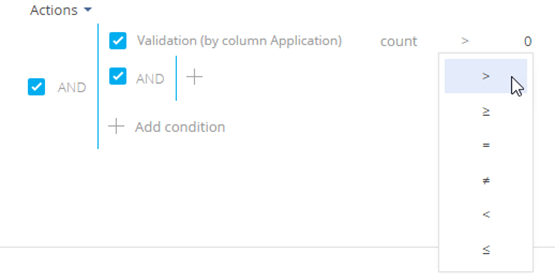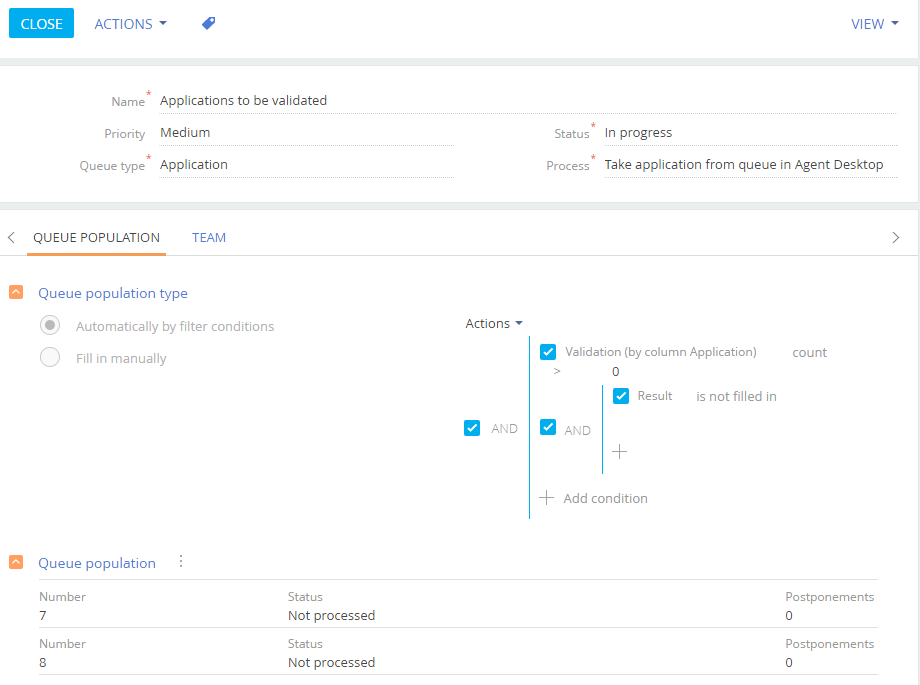How to create and populate a dynamic queue
Dynamic queues are populated automatically. The queue will be populated with records that match a specific filter condition. For example, dynamic queues can be used to process applications sent for verification by managers.
Let's take a closer look at how to create and populate dynamic application queues. We will create a queue of applications that have unfinished verification. To do this:
1.Go to the [Queues] section.
2.Open the [Queues setup] view and add a new element.
3.Specify the name of the queue in the opened window.
4.Select the priority for the queue. The queue priority influences the display order of the queue elements on the home page.
Note
Learn more about elements sorting order on the home page from a separate article.
5.Select a system object in the [Queue type] field. In our case it is ”Application”. You can customize queue objects in the [Queue objects] lookup by clicking the [Queue sorting setup] action in the [Queues] section. After saving the queue you cannot change its type.
Note
The selected object defines the queue type - regular or blind.
6.Select the "In progress" queue status.
Note
The home page displays only active queues. The status of active queues is “In progress”. By default, the status is "Active".
7.Select a business process in the [Process] field. The selected business process will be run each time an agent takes an element from the queue. Select the “Agent desktop: Queue applications processing” business process for applications.
Note
To be able to use a process in a queue, add two global parameters to it: “queueelementId” and “entityRecordId” with the "Unique identifier” type. The record ID from the ([Queue element] object) is passed to the “queueelementId” parameter, and the contact/case/application record ID is passed to the “entityRecordId” parameter.
8.Select the [Automatically by filter conditions] option in the [Queue population type] field group on the [Queue population] tab.
9.Specify the filter conditions in the filter area.
a.Click the [Add condition] link and select the in the opened window.[Activity (by application column)] and [Id] column object. Select the “Quantity” condition type and “>0” value (Fig. 1).
Fig. 1 Setting up the “Quantity > 0” filter condition

b.Add another filter condition: “Result is not filled in”(Fig. 2).
Fig. 2 Setting up the "Result is not filled in” filter condition

Attention
If you do not specify the filter condition for a dynamic queue, the queue elements will not be displayed on the home page.
10.To form a list of agents to process objects from the queue, go to the [Team] tab. Click the [New] button and select the required employees. The selected contacts can process the content of the queue from the home page.
Attention
Only those agents who have the [Active] checkbox selected on the [Team] tab can process the queues. By default, this checkbox is selected for all contacts on the detail. You can clear the checkbox for certain agents. In this case the queue elements of the queue will not be displayed on the home page for these agents.
11.Save and close the page.
To view the content of the queue, select the [Fill queues] action from the action menu of the [Queues] section. Open the queue record. All cases in the current queue will be displayed on the [Queue population] detail (Fig. 3). The data is available in read-only mode.

See also
•How to create and populate a static queue
•How to set up a regular or a blind queue on the home page
•How to sort queue elements on the home page by the object columns
•Processing casesapplications from a regular queue in the home page.
•Processing casesapplications from a blind queue in the home page






